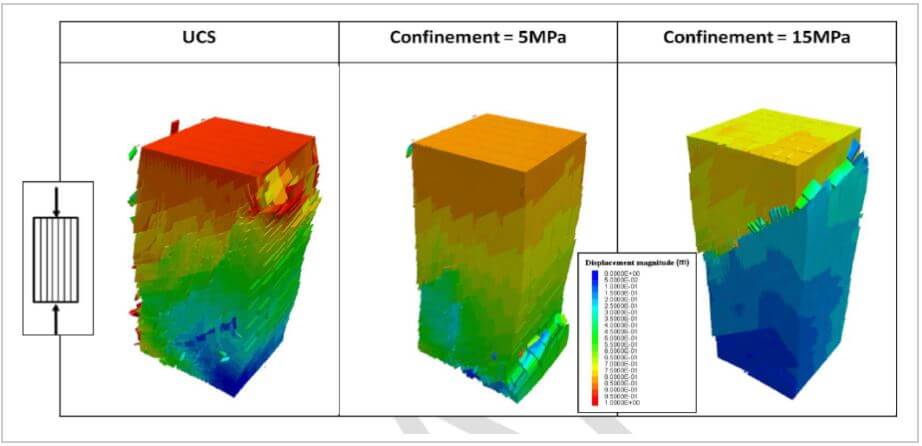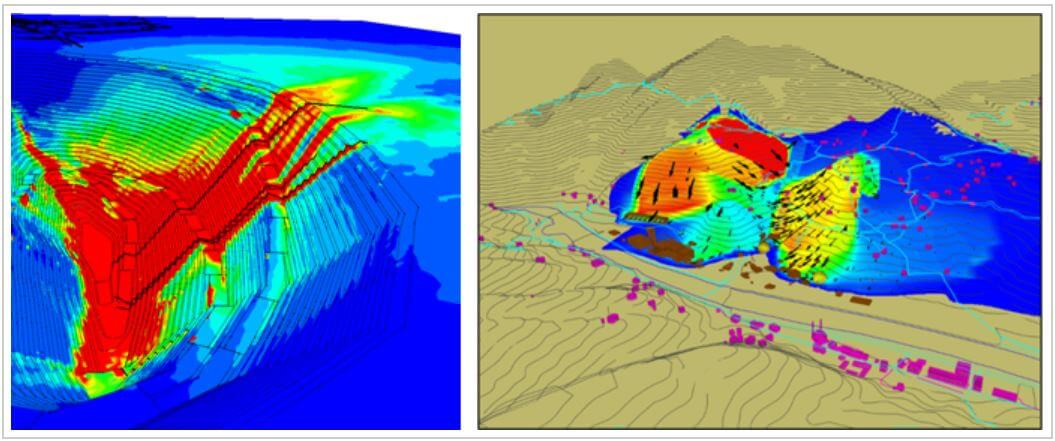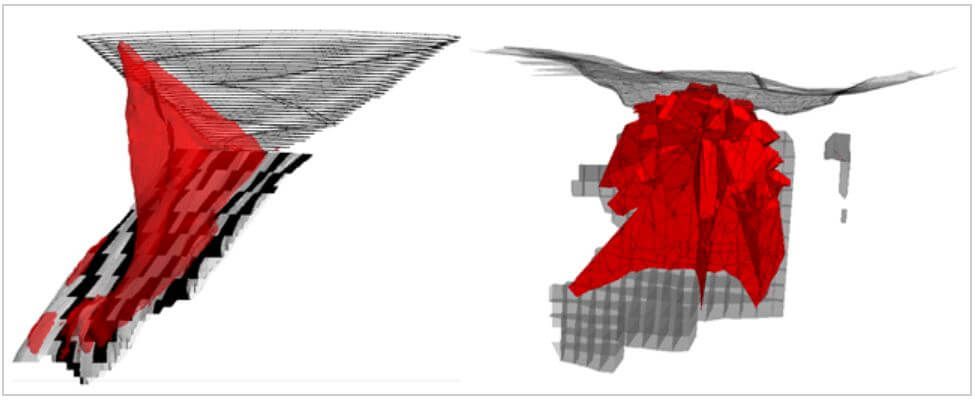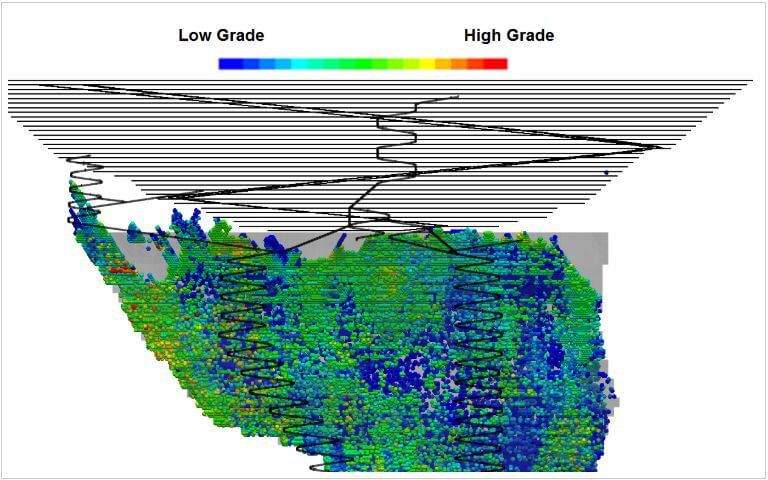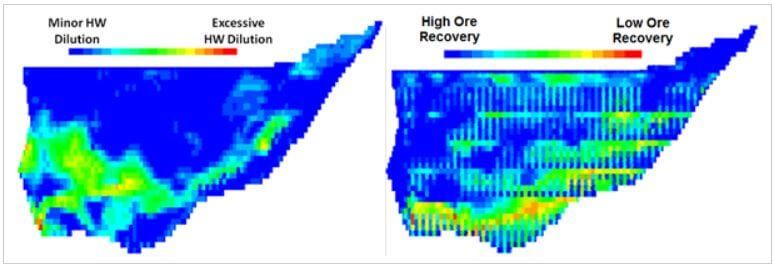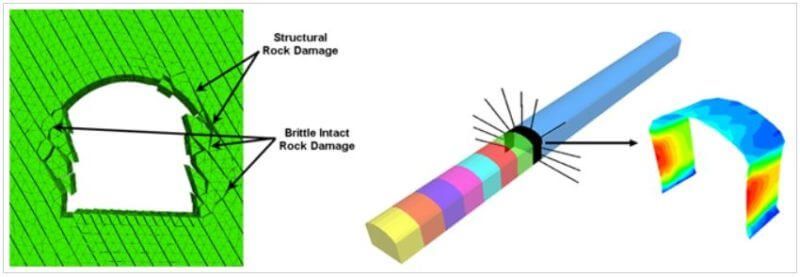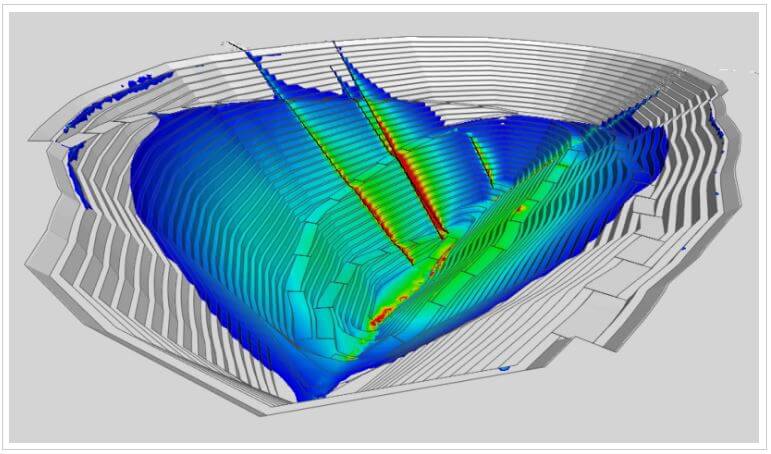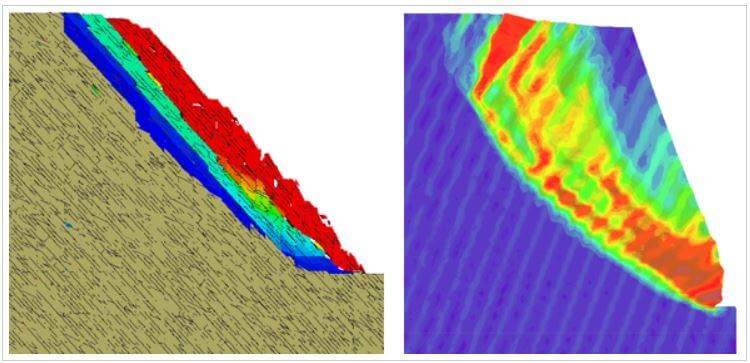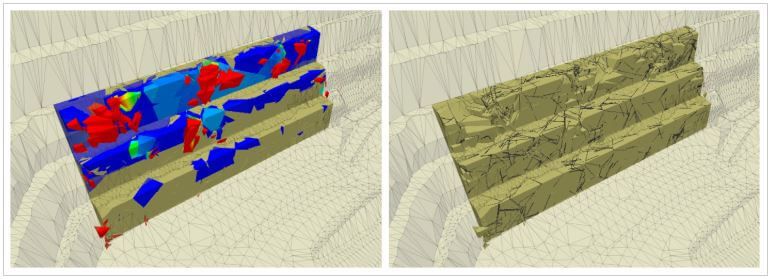Advances in AMC’s Numerical Modelling Capabilities
Advanced numerical modelling is providing AMC’s clients with more cost-efficient, accurate, modelling solutions than ever before. Results from this modelling provide critical inputs into geotechnical components of mining studies, assisting in the optimization of mine design parameters.
AMC conducts advanced numerical modelling using cutting-edge tools. These models can incorporate all major fault structures explicitly. Recently, AMC developed a simple and fast-to-implement process that enables the inclusion of small-scale discontinuities in a mine-scale model using a discrete fracture network (DFN). These DFN models can be deterministic or probabilistic and can be incorporated either implicitly in pseudo-discontinuum models or explicitly in discontinuum models. Figure 1 below shows examples of these two types of models.
For pseudo-discontinuum models, AMC uses non-linear strain-softening constitutive models. These models are confinement-dependent, representing a different pre and post-failure mechanism at various confinement levels. For more detailed analysis AMC can use large-strain analysis using nodal discretization techniques or higher-order-element meshes.
To estimate rock mass strength parameters, AMC uses a combination of traditional empirical methods and the most recent analytical techniques using synthetic rock mass (SRM) modelling (see Figure 2). Alternatively, AMC can conduct pseudo-discontinuum/DFN analysis, removing the requirement for estimating the rock mass strength parameters.
AMC undertakes model calibration and validation using available monitoring data from mine sites. This data typically includes information about displacements, depth of fracturing, seismicity, and surveyed damage locations.
The Costs Need Not Be Higher
There is a perception that high-end numerical modelling — that is, discontinuous inhomogeneous anisotropic non-elastic (DIANE) modelling — is expensive and time-consuming. Although it is true that it can be more expensive than simple linear elastic modelling, a number of factors often cause unnecessary time to be spent and costs to be incurred. Such factors include:
- Including unnecessary details in numerical models.
- Applying inappropriate software programs for the problem.
- Lack of modelling expertise and experience.
- Lack of competition from high-end modelling solution providers.
AMC is aware of the above, and through continuous improvements to its modelling capabilities, can now conduct DIANE analysis to similar budgets and timeframes as those traditionally required for continuous homogenous isotropic linear elastic (CHILE) analysis.
Firstly, through experience and various sensitivity analyses, AMC ensures that only necessary details are included in numerical models. Necessary details are those that can affect the results, considering the accuracy required for any particular problem.
In addition, AMC can employ an extensive range of computer software programs for model construction, solving, meshing, post-processing, and visualization. These include Rhinoceros, Datamine, Vulcan, Surpac, CUBIT, Abaqus, Kubrix, FLAC, 3DEC, PFC, MAP3D, Rocscience, and also several internally-developed software programs and tools.
Our numerical modelling projects are conducted by a team of experienced geotechnical modellers, geotechnical field engineers, structural geologists, mining engineers, and software developers. The interaction of these expert multi-disciplinary professionals, coupled with the AMC peer review process, ensures the highest-quality results.
AMC applies advanced numerical modelling to a range of geotechnical problems. Some examples are outlined below.
Surface Subsidence
AMC uses advanced modelling techniques to forecast surface displacement induced by open-pit (Figure 3a) or underground (Figure 3b) mining activities near critical infrastructure locations.
Caveability Assessment
AMC uses cutting-edge modelling techniques to forecast the caveability of rock mass for block and sublevel caving and longwall operations. Examples are shown in Figure 4.
Advanced cave modelling techniques include DFN modelling, which is used to accurately simulate caving behaviour, and the application of an in-house modulus/density adjustment code for improved stress calculation accuracy in caving conditions.
Material Flow
Material flow modelling is an integral part of AMC caving studies. Material flow modelling is used to optimize the material draw strategy through maximizing ore recovery and minimizing waste dilution (Figure 5).
Features of the material flow code that AMC uses for draw scheduling include the ability to incorporate the actual mine block model and different flow rules for different fragmentation sizes, calibrating models using an operation’s data (or more sophisticated codes like PFC), and couple flow models with the stress-strain numerical models.
Stope Stability Assessment
For stope stability assessments, AMC uses in-house codes that generate waste dilution, backfill dilution, and ore overbreak for individual stopes. Figure 6 shows some examples.
To capture the most accurate stress path and rock mass behaviour throughout the life of mine, AMC creates detailed mining sequences that can incorporate hundreds of individual mining steps.
Through standard post-processing procedures, AMC summarizes the modelling results into easy-to-understand charts, as shown in Figure 7.
Development Stability Assessment and Ground Support Design
AMC uses advanced modelling methods to assess ground support requirements and the stability of drive development. When stoping-induced stresses and rock mass displacements are anticipated, 3D submodelling techniques are used to assess ground support requirements.
AMC models can accurately forecast displacement and damage depth/location/mechanism (see Figure 8). Ground support response and its interaction with the rock mass is simulated by incorporating support elements explicitly in our models.
Slope Stability
AMC offers a full range of cutting-edge modelling and design tools for pit slope stability analysis. Figures 9, 10, and 11 show some examples of open-pit applications of these tools.
For more information regarding AMC’s numerical modelling capabilities, please contact your nearest AMC office. Click here to find out more about AMC's geotechnical capabilities.
Article author:
Abouzar Vakili
Geotechnical Engineer
- These plots show the hangingwall and ore damage expected for each stope at the time when they were mined (results of 110 mining steps are compressed into one final plot).
- This model optimized the support installation time and required capacity in highly-stressed conditions.
- Results of this model correlated very well with observed wedge failures at the mine site.
Subscribe for the latest news & events
Contact Details
Useful Links
News & Insights


